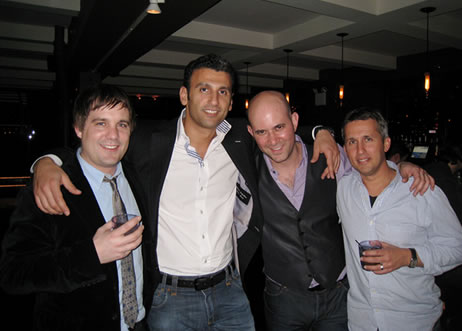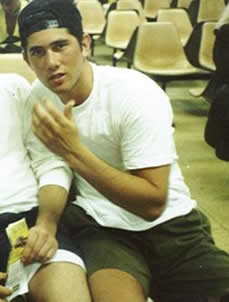
This interview is with Jordan Finger of Ardis Health, which is an online product-marketing company. Because his company sells a physical product, Jordan has to manage more back-office logistics than many of you. He’s also had more international success (in the UK) than anyone I have heard of so far. Ardis Health does a lot of media buying to drive traffic. Also in the interview, Jordan highlights the importance of copy for developing high converting offers.
Full Interview Audio and Transcript
Personal Info
Hobbies and Interests: Trying to Play Golf, Race Cars and Race Boats.
Favourite Sports Teams: Doesn’t follow sports.
Favourite Books:
- E-Myth by Michael E. Gerber
- Good to Great by Jim Collins, Reads Magazines
Favourite Entrepreneurs: Steve Jobs, Steve Wynn, Richard Branson.
Company Website: http://www.ardishealth.com
Fast Track Interview
Adrian Bye: Jordan Finger is with me today. He runs an online product-marketing company called Ardis Health. Jordan, why don’t you tell us a little bit about yourself and your business?
Jordan Finger: I am 34 years old and currently live in New York. My office is in Manhattan.
My current corporation, Ardis Health, was originally founded in March 2001 as Ardis Interactive. My former employer was Audio Book Club, and I was running their online business. Because of a change in business strategy and tight cash flow, they became a victim of the dot-com meltdown. When I left them, I started Ardis Interactive as a media brokerage firm. It was a challenging time, and it was tough to get business. You had to be very resourceful, aggressive, and proactive to find deals and cash flow.
We have evolved into more of a product-marketing company. Our focus has been health and wellness products. In dealing with a physical product, you have different back-office logistics. For example, you have to have a physical place to fulfill and ship a product. We also have to deal with a lot of customer service and customer management issues when shipping the physical product.
Adrian Bye: Can you tell us a little bit about the overall size of the company, such as revenues, orders per day, or shipments per month?
Jordan Finger: In terms of the business, we’re both domestic and international. We have our U.S. business, and we’ve expanded into the U.K. market. We’re looking to expand into France within the next eight months. We’re also looking to expand into Germany, Spain, and Italy.
Our daily averages are 2,000 to 3,000 customer transactions or free-trial sign ups. That might sound small compared to the lead business, which will do 10,000 leads a day. What makes us different is that our customer transactions involve pulling out a credit card and transacting for a product.
We’ve been able to optimize our system for the optimal mix of volume, revenues, and margins. We are very savvy in terms of our media buying. Our business is also based on a network of microsites into which we drive traffic.
Adrian Bye: Are you driving your traffic primarily through CPA-type networks or through media buying as well?
 Jordan: When we started the business, a lot of third-party e-mail, list management, and e-mail marketing existed. As that space became more competitive with lead-gen offers, the growing demand was to accept those offers over trial offers. Our market was squeezed a little bit from that perspective.
Jordan: When we started the business, a lot of third-party e-mail, list management, and e-mail marketing existed. As that space became more competitive with lead-gen offers, the growing demand was to accept those offers over trial offers. Our market was squeezed a little bit from that perspective.
We also saw the ebb and flow of an e-mail. You send an e-mail out this week; you get a rush of sales. You send out to that same list. You get a good response but not quite as big because the amount of volume we’re seeking and the growth of the list are not always in synch.
Most of our business now is based on media buying with display ads and search. Probably less than five percent of our business is accounted for through e-mail list management.
We’re actually buying media on CPM and CPC. We are trying to arbitrage our own offers to back into the effect of Cost Per Acquisition that we’re seeking in order to make our economics work. With a CPA network, you say, “Yes, I’ll pay you this CPA.” Based on that CPA, the margins are already known regarding what the advertiser or publisher will be paid and what is retained.
The difference is that we’re buying all the media, and we’re now risking that media everyday of the week. There’s nothing to say if I buy a CPM display ad that I’m going to yield back the conversion or the response I’m seeking for the business. We have been able to figure out how to make all that work. It’s from being innovative not only from our media buying and our team of media buyers but also leveraging technology to help us optimize our landing and order pages because we are constantly testing.
When you’re dealing with a physical product versus a virtual product, the turnaround time to get a new product to market is not, “There’s something in the press. Let me put it up tomorrow.” You have to get the product in stock. You have to create the brands. You have to develop the microsites. Then, there’s the physical logistics with the fulfillment house getting the inventory in stock, getting all the SKUs coded so the fulfillment center can speak to the CRM system that speaks with the credit card processor. You have to train the customer service reps.
Our turnaround in terms of “bringing something hot and new to the market” is much longer. Therefore, we need to be even more innovative in terms of how we get the most value and the most yield on that offer while we have it in the market.
Adrian Bye: Can you talk about some of the tricks you use on media buying?
 Jordan Finger: I wouldn’t call them tricks per se. It’s more about discipline. With a CPA network, obviously, they’re taking a media risk by letting you pay a CPA with them. Sometimes, they also arbitrage in the media if they’re not running on their own media. There’s mathematics; there’s calculations. When you go into those CPA media, you give them an offer and either it does or doesn’t back in. That either builds or kills excitement right away.
Jordan Finger: I wouldn’t call them tricks per se. It’s more about discipline. With a CPA network, obviously, they’re taking a media risk by letting you pay a CPA with them. Sometimes, they also arbitrage in the media if they’re not running on their own media. There’s mathematics; there’s calculations. When you go into those CPA media, you give them an offer and either it does or doesn’t back in. That either builds or kills excitement right away.
When we’re doing CPM or CPC media, we’re not working to impress an account manager who is trying to make commissions on an offer. We invest more time, money, and resources into making that offer work. We get daily reports that tell us our click rate, conversion rate, projected revenue, and return on advertising. Whatever we measure is what gets improved. I’ve impressed upon my team that we need to look at these numbers daily, weekly, and monthly. If anything is going too astray, we could address it. If anything might be a hidden success, we could exploit it.
Adrian Bye: Where does someone start with media buying? Do you go to the niche sites? Do you go for mainstream traffic?
Jordan Finger: Just as e-mail has been so effective because it has a lot of eyeballs from a captive audience, the same thing holds true in terms of media or doing search. You have access to many eyeballs. You then have this opportunity to impress upon that person at this time. What am I going to do with that impression? It’s identifying the audience. It’s targeting the message. It’s making an offer that resonates.
You have to be where the people show up and where the eyeballs are. You can’t go too niche because we all want to grow our businesses. You still have to go to the large networks and the large sites.
For example, let’s take a diet product that’s selling on theknot.com. Surviving on brides alone is not going to allow a business to grow in scale. That same woman going into that site is probably also going to the Yahoo Homepage or using a Yahoo tool to go into the bridal or health and wellness sections. You have to hit them there instead of that niche of just people getting married. That woman lives her life outside of just her wedding. She probably works. She’s getting married. She’s making travel arrangements. She’s looking for all these different services and products online. People still tend to go to those high-traffic sites.
We’re more interested in how do we target that person and more like them on a broader sense. We found that specific messaging sometimes is not really always as effective when you’re trying to hit a broader market. Definitely speaking in the voice of the person is effective. Instead of, “Hey, you’re getting married” it might be, “Hey, you’re working. You don’t have time to spend two hours in a gym like you did when you were in college.” It’s the same person, but you are speaking more to their lifestyle and why they’re going to these sites. It’s speaking to them in that tone. It’s just the messaging strategy.
Adrian Bye: When you’re starting a media buy, do you have any techniques you use for the buying terms or do you just put down money, test it, and see how it goes?
 Jordan: We try to do more media planning and market research. If we’re going to launch a new product, we try to understand the demand for the product, the competitive landscape, what our competitors are buying, some of the rates they’re paying, and the messaging they’re using. If they’re all saying the same thing, we look at how we can speak a different voice and still relate to that audience.
Jordan: We try to do more media planning and market research. If we’re going to launch a new product, we try to understand the demand for the product, the competitive landscape, what our competitors are buying, some of the rates they’re paying, and the messaging they’re using. If they’re all saying the same thing, we look at how we can speak a different voice and still relate to that audience.
Once we understand those things, we’ll start with a test budget. You have to spend some money in different channels and placements. At times, you have to lose a little money to see what creative works, what placement works, and what offer works. That’s the media risk we’ve been taking.
In terms of weight-loss, people are still looking to lose weight. If you look at Weight Watchers, every year it’s still Weight Watchers. They may have improved their system a little bit, but they always have a fresh, new message they’re trying to communicate. If they just spoke to the person the same way as all their competitors, their voice is not going to stand out. We put a lot of focus on that.
From that, we can carve our niche. All the players I respect and compete with in my market space have been able to reinvent themselves and how they communicate to the market. There have been different techniques, and they all have a level of success.
It’s not just about buying the media or paying this CPA. It’s how are you going to speak to that person differently today. They’ve been spoken to the same way for the last “x” amount of time, and that’s going to get tiring very quickly.
It’s a problem-solution game. Identify the consumer’s potential problem or issue. Give them the solution through the benefits they’ll get from using your product or services. Support the solution with the features of your product and services. If you’re the only one selling through that benefit, no one can compete on that. If you make it unique to you, then you win the game.
Adrian Bye: Who does all your copy?
Jordan Finger: I have an in-house staff, and I have a contracted staff of trained direct response marketers. They know all the tricks of the trade, and they know the right way to communicate the message to the consumer.
It could be even something simple as buying a keyword phrase on Google. We can have a phrase that works specifically with a Web site, but that same phrase won’t work with another Web site. It’s just subtleties in that. Constantly having that flow of ideas and that copy coming in is very critical to maintaining, reinventing, and growing the business.
In the early days, there wasn’t really much in terms of copy. It was mostly media negotiations. It was, “You have a list. Do you want to run this offer? Great, I’ll run your offer.” It works for awhile, and then you give them a new offer. It was really knowing who to call, who to cut a deal with, and that was it. The emphasis on the copy and the messaging wasn’t so important.
Now, it’s become more competitive. The creative process is very critical to the success of an offer. It’s easy for someone to say, “Sign up for a free laptop” or “Get a free bottle of green tea diet pills.” The hard part is getting the consumer to respond to that offer, getting them to want to take your offer, and getting them to want to keep buying what you sell.
Adrian Bye: When I talk to people about international, I hear horror stories. You mentioned that you’re doing business in the United Kingdom. How well are you actually doing with international?
Jordan Finger: It was not an easy process. We originally started our effort in 2004 to set up the entire back-end due diligence with bank accounts, corporations, processing accounts, fulfillment, and customer service. That took some time and a lot of paperwork.
You have to find what channels, pricing, and offers work. Even though it’s a much smaller market, there’s sometimes less competition per se. You can’t just show up, especially with a physical product, and say, “Hey, here I am.” You have to set up the back-office operation. We invested a lot of time, money, and resources to do it the right way. Since the back-office operation became a non-issue, we can focus our energy on the media and the marketing aspect. That’s helped make the program successful. Right now, 40 percent of our business is coming from overseas.
Adrian Bye: What are some of your top offers right now?
Jordan Finger: We do a lot of the weight-loss supplements. We do some energy products. We’re trying to diversify our product portfolio. You can never fulfill that demand for health and wellness supplements completely, but we are developing other products outside of that category.
When we only ran on CPA networks, the offer had to work within their environment or it didn’t work at all. Now we have this ability and knowledge to have a lot more consistency in terms of our media buying, our display ads, our search, and our contextual. We can really put anything in those channels now and make it work whether it’s supplements or an e-book.
We have a completely different perspective on our business because of our media ability. Now, we’re saying, “What if…” “What if we sold something that was not thousands of orders?” Maybe it’s 50 orders. That’s okay because I’m not trying to satisfy the needs of an account manager at a CPA network. If I’m doing something on a search or banner, I don’t have to fulfill those expectations. I just have to fulfill the economics of the media I already bought.










